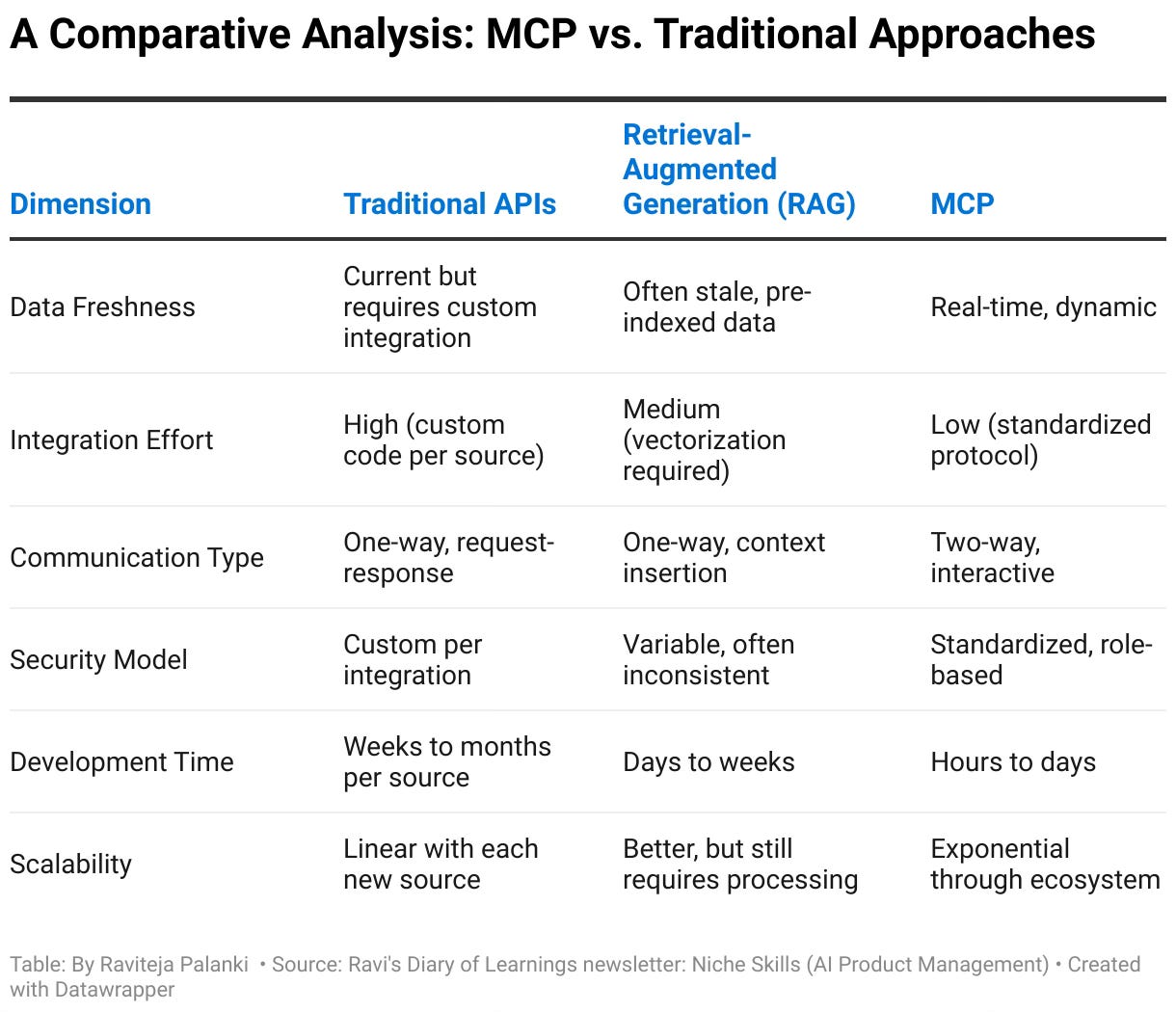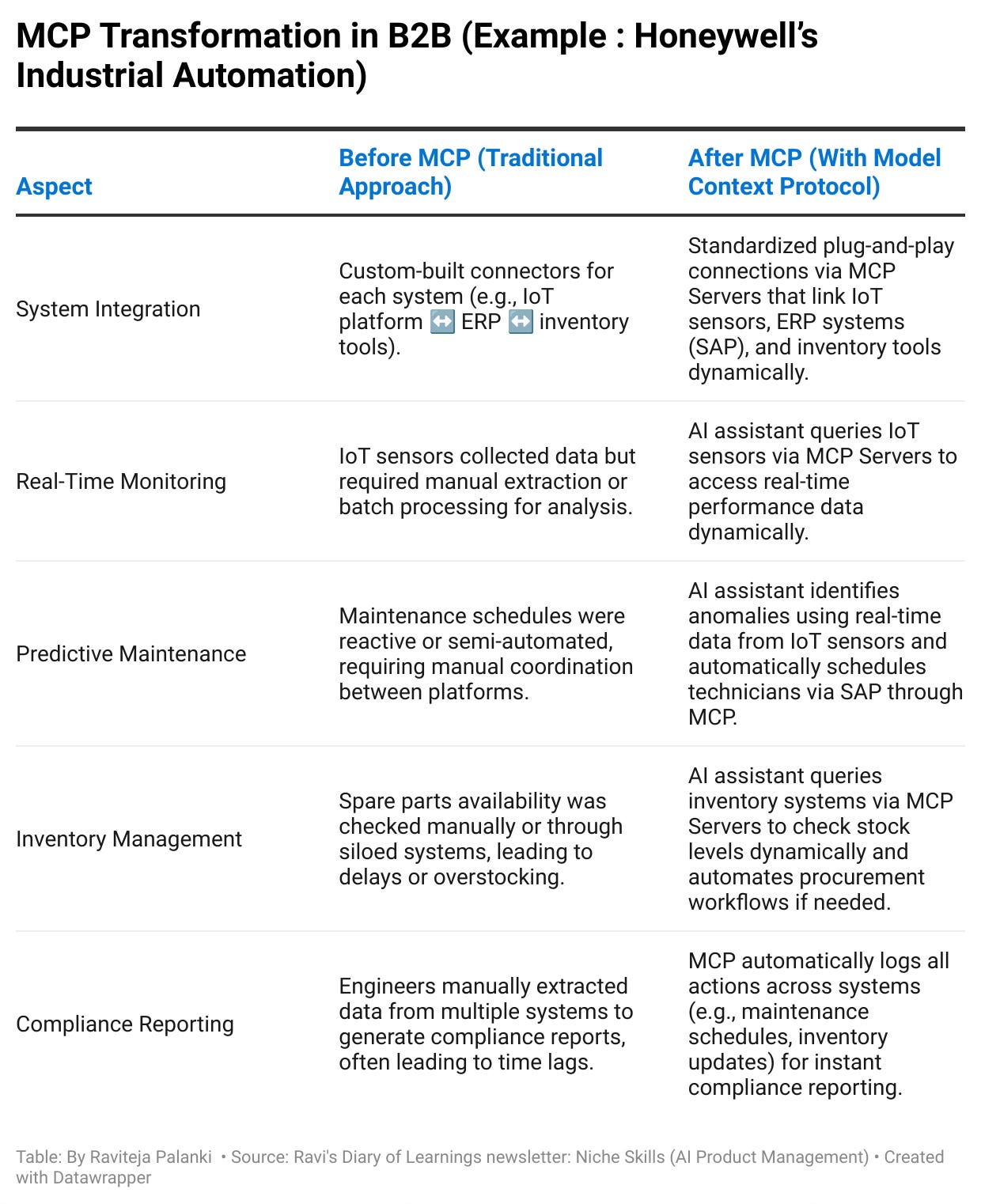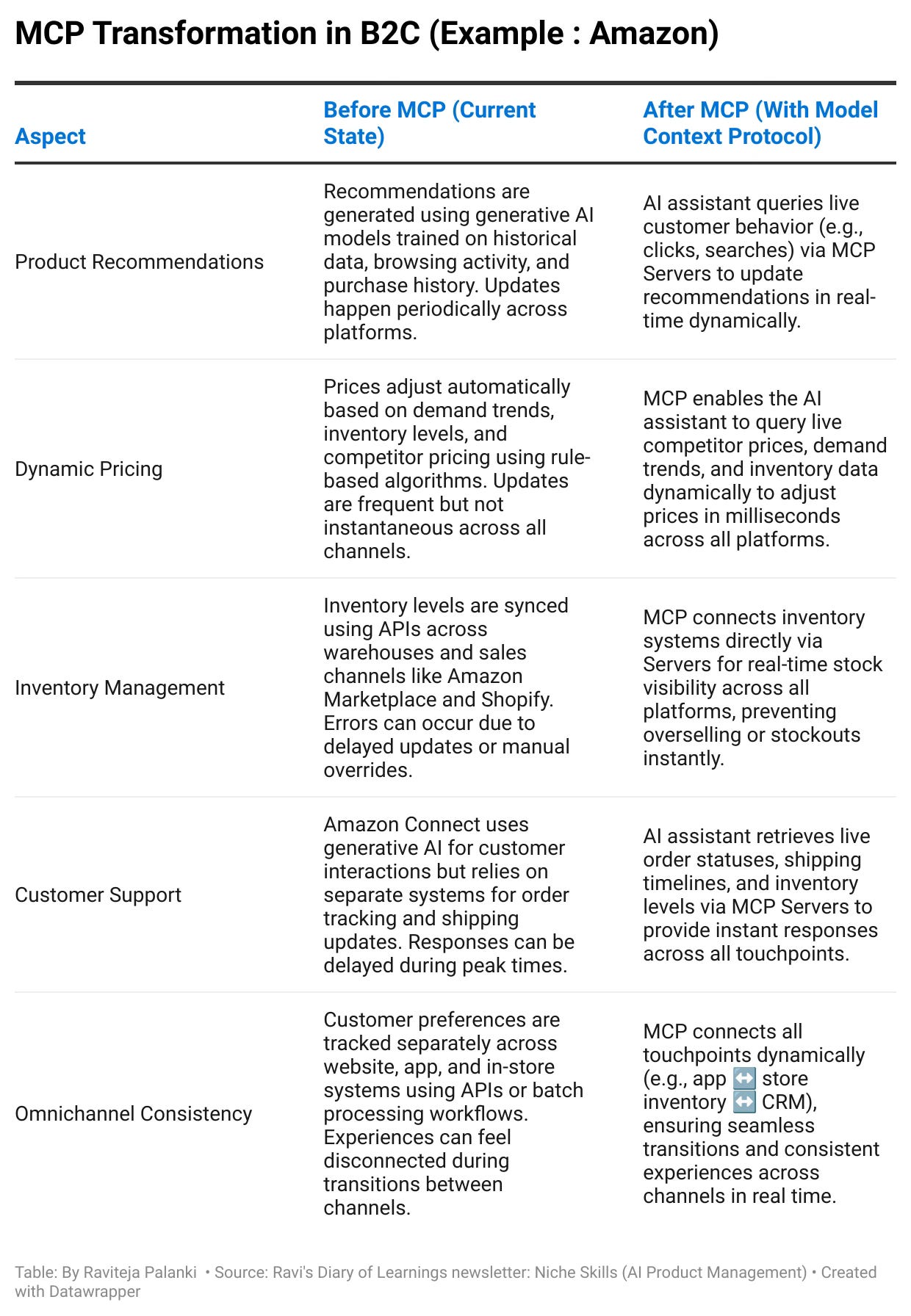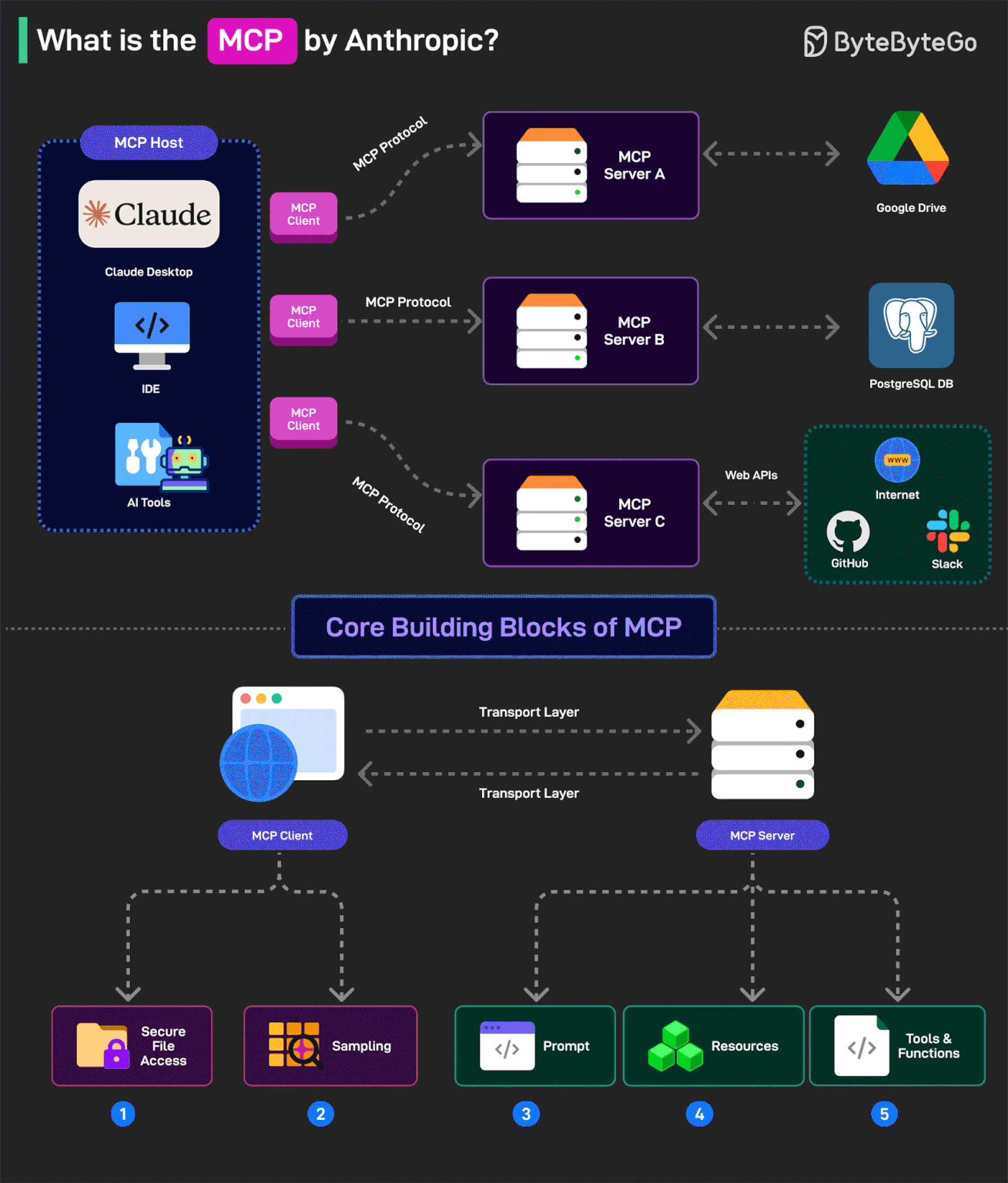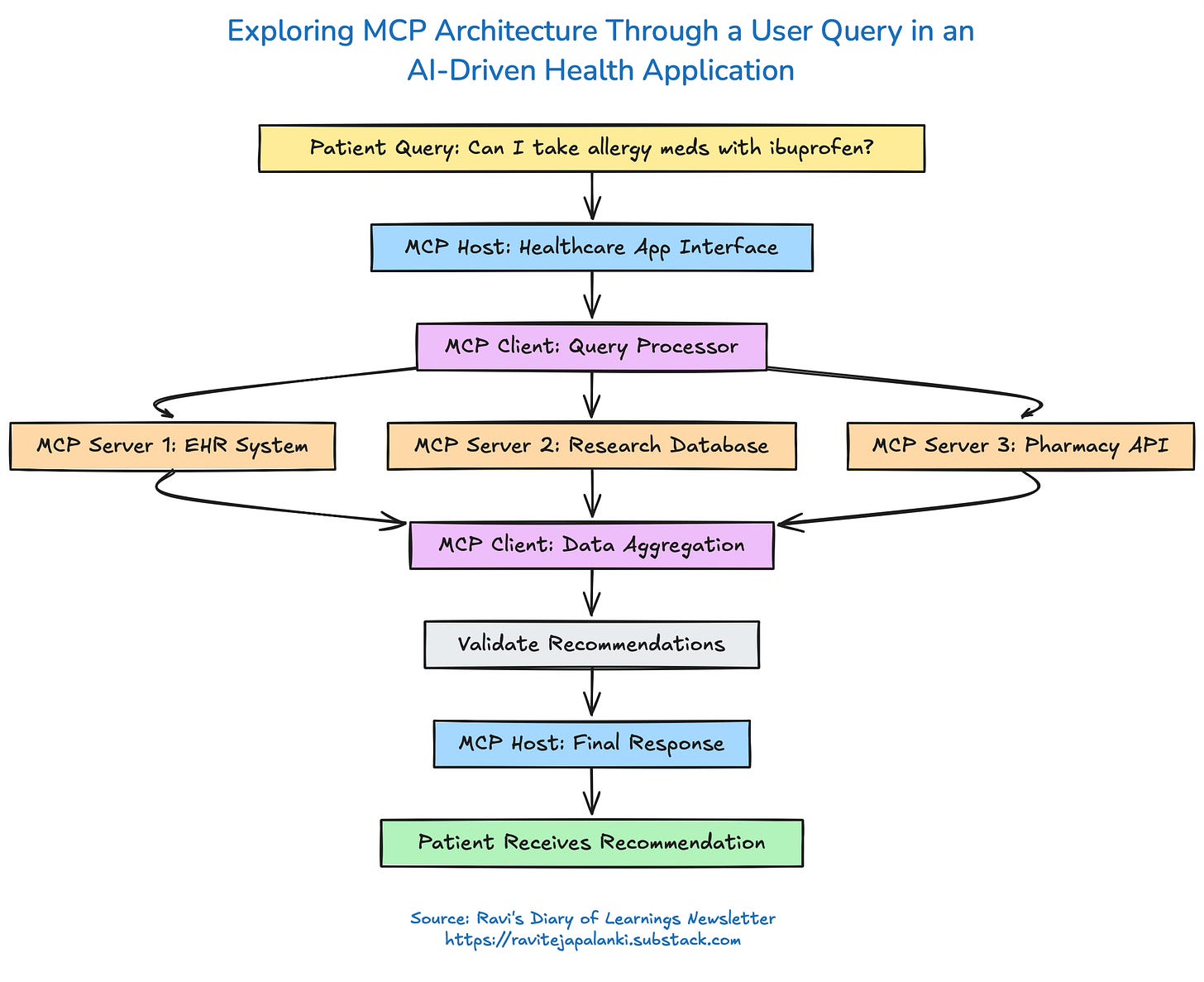Model Context Protocol (MCP): The Universal Translator That Will Redefine Our AI Products
The exciting revolution in how AI connects to data isn't just for engineers – it's reshaping what's possible for every Product Manager. Here's what we need to know.
In the last two weeks, your feeds have likely been flooded with announcements from Anthropic, Perplexity, and several other AI frontrunners—all mentioning "Model Context Protocol" or MCP. What appeared at first glance as another technical acronym is signaling one of the most significant shifts in how AI products will be built, compete, and scale in the coming years.
"MCP stands to do for AI what HTTP did for the internet," explains Harrison Chase, CEO of LangChain. "It's not just another integration standard—it's the foundation for an entirely new ecosystem of interoperable AI applications."
Consider this: Before, HTTP wasn't technically superior to alternatives. Still, its standardization created how modern web browsers and servers communicate when the Internet was a fragmented collection of incompatible systems. Similarly, AI systems today are isolated islands, each requiring custom connectors to access the data they need. MCP promises to eliminate this fragmentation overnight.
For product managers, this shift is significant.
The competitive AI landscape is rapidly transforming from who has the best model to who can build the most seamless connections between models and valuable data.
Those who understand MCP now will have an 18-24 month advantage in building products that leverage this new paradigm, potentially reducing integration costs by 40-60% while accelerating time-to-market by 3-5x for AI features.
So what exactly is happening, why is it suddenly everywhere, and why should you—as a product leader—care deeply about understanding it?
What You'll Learn in This Guide
What Is Model Context Protocol?
Understanding MCP through a relatable example
Why MCP Matters Now?
MCP vs. Traditional Approaches
Real-World Applications - How B2B and B2C companies can transform with MCP
Inside MCP Architecture - The technical essentials every PM needs to understand
MCP in the Agentic World
Strategic Business Benefits - Why major companies are rapidly adopting MCP
Critics' Perspectives & Road Ahead of MCP
Key Takeaways & Action Plan for Product Managers
What Is Model Context Protocol?
Model Context Protocol (MCP) is an open standard developed by Anthropic that allows AI systems to connect with external data sources—like databases, APIs, or file systems—in a standardized way. Instead of building custom integrations for every tool, MCP provides a universal framework that lets AI models retrieve, process, and act on structured data dynamically and securely.
At its core, MCP solves what engineers call the "N×M problem"—the exponential complexity of connecting multiple AI models (N) to various data sources and tools (M). Rather than building custom integrations for each combination, MCP provides a standardized way(plug-and-play framework) for any AI to connect to any data source or tool.
Let’s Understand This Better With an Analogy
💡 The Restaurant Analogy: Upgraded Version
Imagine you’re at a food festival with hundreds of restaurants from different countries:
Before MCP: You’d need to learn each restaurant’s language, menu codes, ordering process, and payment methods individually - a logistical nightmare akin to building custom API integrations for every system your AI needs to access.
With MCP, you have a universal translator who fluently speaks every restaurant’s language, understands their menus instantly, handles payments seamlessly, and even remembers your preferences across all restaurants.
In this analogy:
The translator is MCP itself.
The restaurants represent the external tools or data sources (e.g., Google Drive or PostgreSQL).
Your preferences are the structured prompts guiding the AI’s interactions.
Why It Matters Now
The Integration Problem It Solves
AI models are becoming more powerful but face three critical challenges when interacting with external systems:
Fragmented Ecosystems: Integrating multiple tools requires custom coding for each connection—time-consuming and unsustainable at scale.
Static Knowledge Limits: Traditional models rely on preloaded data that quickly becomes outdated or irrelevant.
Security Risks: Ad-hoc integrations often lack consistent security protocols, exposing sensitive data to breaches.
MCP addresses these issues by providing a universal protocol simplifying integration while securely ensuring real-time access to dynamic data.
A Comparative Analysis: MCP vs. Traditional Approaches
While RAG improved AI's ability to access static information, MCP transformed AI's ability to interact with dynamic systems in real-time with standardized security and access controls.
Real-world Examples
Let’s consider some hypothetical Real-World applications of MCP in both B2B and B2C contexts to better understand this transformation.
B2B Context: Honeywell
Honeywell operates in industrial automation, where predictive maintenance, inventory management, and operational efficiency are critical. Before MCP, Honeywell relied on traditional integrations like APIs and custom-built connectors, which were functional but limited in scalability and real-time adaptability.
🔑 Key Impact:
✅ Downtime reduced by up to XX% through improved predictive maintenance.
✅ Operational costs cut by XX% due to efficient automated workflows.
✅ Scalability improved as new tools can be integrated seamlessly without custom coding.
B2C Context: Amazon
Amazon is already a leader in leveraging AI for personalization, dynamic pricing, and inventory management. However, its current systems rely on advanced but fragmented integrations, such as APIs, pre-defined rules, and batch-processing workflows. MCP offers a way to unify these processes, enabling real-time adaptability and seamless cross-system communication.
🔑 Key Impact of MCP on Amazon’s Operations
✅ Improved Conversion Rates: Hyper-personalized recommendations based on live data improve conversion rates by up to XX%.
✅ Enhanced Customer Satisfaction: Instant responses powered by dynamic inventory updates reduce cart abandonment by XX%.
✅ Revenue Growth: Dynamic pricing ensures competitiveness while maximizing margins during high-demand periods.
✅ Omnichannel Retention: Seamless cross-channel experiences boost customer retention by XX%.
How MCP Works: The Architecture The Essential Components
MCP follows a client-server architecture with three primary components working in harmony:
MCP Host: The environment where users interact with AI (like Claude Desktop or an IDE)
MCP Client: The component inside the AI application that formats requests
MCP Server: The connector between the AI and external systems (databases, APIs, etc.)
These components are built around five core building blocks (primitives):
For Clients:
Secure File Access: Controls how AI accesses files with appropriate permissions
Sampling: Allows AI to get help with tasks like generating database queries
For Servers:
Prompts: Templates that guide the AI in specific contexts
Resources: Data objects the AI can reference
Tools: Functions the AI can execute (like database queries)
Let’s understand this technical deep dive using a healthcare B2C example (patient interaction with an AI health assistant) to explain how MCP works step-by-step.
Example Scenario: AI-Powered Patient Consultation
A patient asks an AI health assistant:
"Can I take my allergy medication with ibuprofen? I have a history of kidney issues."
Key Components & Data Flow
1. MCP Host: Patient Interface
Action: The patient asks a question via the healthcare app interface
MCP Function: The Host authenticates the user and securely passes the query to the MCP Client
Business Value: Creates a single trusted entry point for patient healthcare queries
2. MCP Client: Query Processor
Action: Analyzes query, identifies medication interaction check + kidney history relevance
MCP Primitives Used:
Secure File Access: Enforces HIPAA-compliant permissions for accessing patient's medical history
Sampling: Generates optimized database queries to retrieve relevant kidney test results
Business Value: Ensures security compliance while breaking complex medical questions into structured tasks
3. MCP Servers: Medical Data Integration
EHR (Electronic Health Records) Server
Action: Retrieves patient's kidney function test results and medication history
MCP Primitives Used:
Tools:
queryPatientHistory()function that safely executes FHIR-compliant database queriesResources: Returns structured patient data (kidney function: GFR 65, medication list)
Business Value: Eliminates the need for custom EHR integrations (saving $XXK+ in development costs)
Medical Research Server
Action: Analyzes potential interactions between allergy medications and ibuprofen
MCP Primitives Used:
Prompts: Structured template guiding interaction analysis: "Identify contraindications between {drug1} and {drug2} for patients with {condition}"
Resources: Access to peer-reviewed medical literature database showing ibuprofen risks with kidney impairment
Business Value: Ensures evidence-based recommendations without requiring continuous model retraining
Pharmacy API Server
Action: Locate available alternative medications (acetaminophen) at nearby pharmacies
MCP Primitives Used:
Tools:
checkLocalAvailability()function that queries pharmacy inventory systems
Business Value: Connects previously siloed pharmacy systems without custom development
4. Data Synthesis & Response Generation
Action: All data points integrated into a comprehensive, medically-sound recommendation
MCP Function: The client standardizes responses from all servers into a unified format
Business Value: Reduces clinician review time by XX% through high-confidence, validated recommendations
5. Final Personalized Response
Patient Receives: "Based on your kidney function test results from March 15th, combining your current allergy medication (loratadine) with ibuprofen may stress your kidneys. Consider acetaminophen instead, available at three pharmacies within 2 miles of you. Would you like directions to the closest one?"
Business Value: Reduces urgent care visits for medication interactions by XX%
How MCP Powers AI Agents
We are entering an era where AI systems are no longer passive tools—they are becoming agents capable of reasoning, decision-making, and autonomous action. These agents operate in a layered architecture, and the Model Context Protocol (MCP) can be the glue that enables them to interact seamlessly with external systems.
Today's AI tools work alone. MCP lets them work together, like specialists in a hospital consulting on a complex case. One AI could analyze your data while another helps plan your schedule, sharing information seamlessly.
Why it matters: Products can solve more complex problems by combining specialized AI capabilities without complicated integration work.
MCP allows AI agents to discover and use new tools without waiting for developers to add them. It's like your phone automatically finding new apps that solve your current problem.
Why it matters: Your AI products can continuously improve without requiring code changes for each new capability.
With MCP's structured communication, you can see exactly which systems your AI consulted and why. It's like getting a doctor's note explaining which specialists were consulted for your diagnosis.
Why it matters: You can understand, explain, and improve how your AI makes decisions—critical for building user trust and meeting regulatory requirements.
Why Major Companies Are Rapidly Adopting MCP?
Strategic Business Benefits
Development Velocity: Organizations typically spend 60-70% of AI project resources on integration rather than innovation. MCP dramatically reduces this "integration tax" and potentially flips this ratio, allowing more resources to focus on value creation.
Competitive Differentiation: As Dropbox, Google, and other major players implement MCP, they create experiences where their AI assistants can seamlessly access proprietary data—creating unique value that competitors can't easily replicate.
Risk Mitigation: With standardized security controls and access management, MCP reduces the compliance risks associated with ad-hoc AI integrations.
Developer Ecosystem Strategy: Companies that embrace MCP early are positioning themselves at the center of emerging developer ecosystems, similar to how API strategies defined platform winners in previous technology waves.
For Day-to-Day Product Managers
Faster Time-to-Market: Eliminates the need to build custom data connectors for every AI feature.
Enhanced Product Capabilities: Products using MCP-enabled AI can offer -
More personalized experiences through real-time data access
Greater contextual awareness across user journeys
Resource Allocation Shift with MCP:
Before MCP:
🛠️ 70% on integration challenges (custom connectors, APIs, data access)
✨ 30% on user experience innovation
After MCP:
🔌 30% on integration management
🚀 70% on experience refinement (personalization, features, user journeys)
This allows product teams to focus on value delivery rather than technical hurdles.
Critics' Perspectives
No technology is without criticism, and MCP faces several legitimate challenges:
Skeptical Viewpoints
Concerns About Novelty: Some critics argue MCP merely repackages existing API concepts without fundamental innovation.
Existing standards like OpenAPI already simplify integrations; adding another layer could complicate workflows unnecessarily.
Authentication Challenges: The protocol doesn't yet fully solve complex authentication scenarios across multiple systems.
Developers still need external mechanisms to manage API credentials
Adoption Uncertainty: Similar to OpenAI's custom GPT or plugin system, widespread adoption isn't guaranteed.
Critics argue that even with tool definitions and prompts, current models often fail to utilize tools, casting doubt on MCP's reliability correctly
Supporters acknowledge these limitations but emphasize MCP's potential as an ecosystem play rather than a technical silver bullet.
Similar to HTTP's early days, the value lies in standardization itself—creating a unified language for AI systems to interact with the world.
The Road Ahead: MCP's Transformative Potential
While most analyses focus on MCP's technical architecture, the true revolution lies in its ecosystem effects.
AI App Store Revolution
MCP is creating an "AI App Store" ecosystem where developers can build specialized tools that any AI can instantly use. Your AI assistant could gain new abilities overnight without requiring a full update.
Democratizing AI Development
Small teams can now build powerful AI tools by connecting to pre-built MCP servers without needing expertise in every domain. This will unleash a wave of innovation across industries.
Rise of AI Orchestrators
Future AI systems will coordinate multiple specialized tools to solve complex problems. Imagine a travel assistant that books flights, checks your calendar, monitors weather, and updates your expense report—all through seamless MCP connections.
Dynamic AI Capabilities
AI systems using MCP will discover and learn new tools on the fly. When facing a new task, an AI could search for relevant MCP servers and integrate them without human intervention, creating assistants that continuously evolve.
Standardization & Interoperability
As MCP adoption grows, companies will more easily switch between different AI models without rebuilding integrations—similar to how any web browser can access any website thanks to HTTP.
Ethical & Governance Frameworks
The power of MCP-enabled AI systems will require new governance approaches. MCP's design includes safeguards like requiring user permissions for sensitive actions, but we'll need comprehensive frameworks for these connected systems.
👉 Key Takeaways for Product Managers
✅ MCP is not just a technical standard – it's a strategic shift in how AI products interact with data and tools
✅ The open-source nature of MCP means lower barriers to entry but requires thoughtful implementation
✅ Product planning cycles should now include MCP integration as a core consideration for AI features
✅ The competitive landscape is shifting from who has the best models to who can best connect models to valuable data
🎯 Potential PM Action Plan: Next Steps
While it's too early to have concrete examples, the adoption of MCP is likely to influence how product roadmaps are created and managed.
Audit our data sources and identify which would benefit most from MCP connectivity.
Identify high-impact workflows in your product(s) that rely on fragmented systems—these are prime candidates for transformation with MCP.
Focus on areas where real-time data access can add immediate value.
Collaborate with engineering teams to pilot one high-impact use case (e.g., connecting your CRM system via an MCP server).
Identify partner ecosystems where MCP integration could create new product opportunities.
Integration Platforms: "MCP management platforms" help organizations monitor, secure, and optimize their MCP connections.
MCP-Native Applications: Applications designed from the ground up to leverage MCP connections will emerge with fundamentally different architectures
Prioritize MCP server development for our most valuable proprietary data.
Explore the MCP GitHub repository (https://github.com/ppl-ai/modelcontextprotocol) to understand implementation details.
Note: Directories listing many plug-and-play MCP servers are already emerging, creating app-store-like marketplaces for AI capabilities.
Conclusion
The AI revolution is moving from an era of isolated intelligence to connected intelligence.
MCP represents a fundamental shift from isolated AI capabilities to an interconnected ecosystem of AI services.
The most successful product managers in the next 18 months won't be those who simply deploy the best models—they'll be the ones who create the most valuable connections between models and data.
"MCP doesn't just change how AI connects to data—it changes what kinds of products become possible." - Harrison Chase, CEO of LangChain
The question isn't whether AI systems will eventually adopt standardized protocols like MCP—it's whether your products will lead or follow in this new paradigm.
By taking action today to understand and implement MCP, you're positioning your organization at the forefront of the next AI revolution: the age of connected intelligence.
Your move.
Thanks for reading Ravi's Diary of Learnings! Subscribe for free to receive new posts and support my work.
Continue to read more such blogs here:
AI Product Management – Learn with Me Series
Welcome to my “AI Product Management – Learn with Me Series.”


